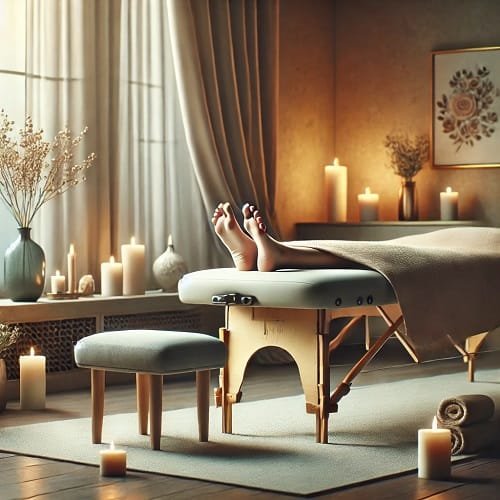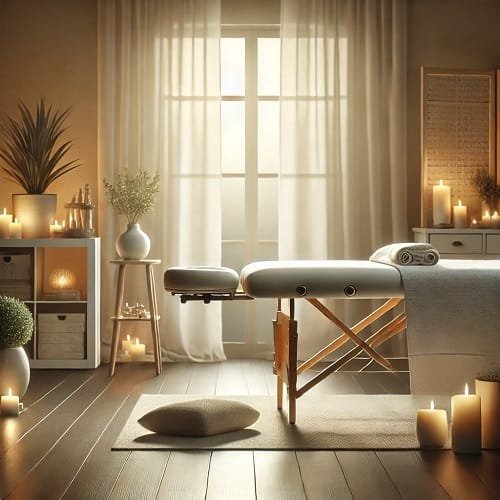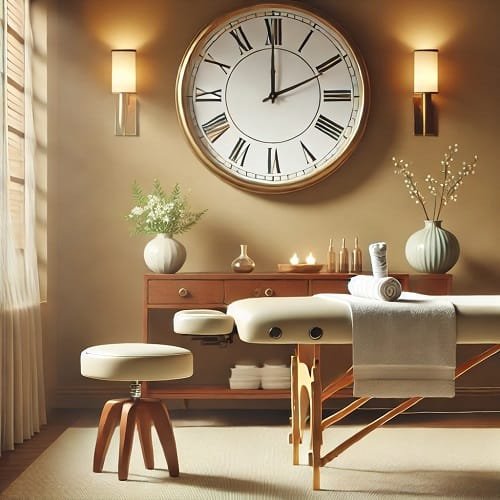Jump to Section
I. Introduction
Have you ever experienced the soothing relief of a foot and lower leg massage? Whether you’re battling daily stress, dealing with muscle tension, or simply looking for a moment of relaxation, this simple yet incredibly effective therapy offers a world of benefits that can leave you feeling rejuvenated. Imagine the comfort of having your feet and lower legs treated to a therapeutic massage that not only provides immediate relief but also contributes to long-term well-being. If you’re someone who spends long hours on their feet, exercises frequently, or just craves relaxation, the power of a foot and lower leg massage should not be underestimated.
The health of our feet and lower legs is often overlooked, despite playing a crucial role in maintaining overall physical wellness. Our feet carry us through the day, supporting our weight, providing balance, and absorbing shock with every step. The lower legs, too, bear the burden of our daily movements, helping to propel us forward and ensuring fluid motion. However, due to factors such as prolonged standing, excessive exercise, or even poor posture, these areas are prone to tension, pain, and fatigue. Keeping them in good health is essential not only for physical comfort but for enhancing our overall quality of life.
In this article, we’ll dive into the 15 incredible benefits of foot and lower leg massage, highlighting how this simple yet powerful therapy can relieve stress, improve circulation, promote healing, and more. Whether you’re new to foot massages or a seasoned enthusiast, these benefits will inspire you to incorporate this wellness practice into your routine.
II. What Is a Foot and Lower Leg Massage?

A foot and lower leg massage is a therapeutic technique that focuses on relieving tension, improving circulation, and promoting relaxation in the feet and lower leg muscles. By applying various pressure techniques and movements, such a massage targets areas that carry the weight of our bodies daily, helping to alleviate discomfort and enhance overall well-being. Whether performed professionally or at home, foot and lower leg massages offer significant benefits for both physical and mental health.
There are several types of foot and leg massages, each with its own unique approach:
- Reflexology: This technique is based on the belief that specific pressure points on the feet correspond to organs and systems in the body. By stimulating these points, reflexology can help balance the body and promote healing.
- Swedish Massage: Known for its gentle and relaxing strokes, Swedish massage uses long, flowing movements to relieve muscle tension, reduce stress, and improve circulation in the feet and lower legs.
- Deep Tissue Massage: This method involves more intense pressure aimed at reaching deeper layers of muscle tissue. It’s particularly effective for chronic pain, muscle stiffness, and injuries in the lower legs and feet.
Foot and lower leg massage works by using a combination of techniques such as kneading, rolling, and applying pressure to specific areas. These movements help to release tight muscles, improve blood flow, and promote the body’s natural healing processes. Whether you’re seeking relaxation or relief from chronic pain, a foot and lower leg massage is a simple yet powerful way to support your overall health.
III. 15 Incredible Benefits of Foot and Lower Leg Massage

A foot and lower leg massage offers more than just a relaxing experience – it brings numerous health benefits. Below, we explore the top 15 incredible advantages of this therapeutic practice, highlighting how it positively impacts your physical and mental well-being.
1. Relieves Stress and Anxiety
One of the most immediate benefits of a foot and lower leg massage is its ability to reduce stress and anxiety. When massaging these areas, the body activates its relaxation response. As pressure is applied to specific points, it stimulates the production of endorphins, which are natural mood elevators. Additionally, the gentle manipulation of muscles helps to lower cortisol levels, the hormone responsible for stress. The rhythmic movements and soothing pressure promote relaxation throughout the body, allowing both the mind and body to de-stress. For those battling daily stressors, this therapeutic touch can be a game-changer for mental wellness.
Impact: A regular foot and lower leg massage offers powerful stress relief, helping to combat feelings of anxiety, mental fatigue, and emotional tension.
2. Improves Circulation
A foot and lower leg massage is incredibly effective at improving circulation. By stimulating the muscles and tissues in these areas, massage promotes better blood flow, which is crucial for overall health. When blood circulates more effectively, it helps carry oxygen and essential nutrients throughout the body, supporting healing and overall vitality. Additionally, improved circulation can reduce swelling and help prevent conditions like varicose veins. Regular foot and leg massages are particularly beneficial for individuals who stand for long periods, as they help reduce fluid retention and encourage healthier blood flow.
Impact: Whether you’re seeking to improve circulation or reduce swelling, a massage for your feet and legs can enhance blood flow, providing vital health benefits and promoting long-term vitality.
3. Boosts Immune System
Foot and lower leg massage is not only a relaxing experience but also one that can significantly boost your immune system. By stimulating the lymphatic system, this type of massage helps to increase lymph fluid movement, which in turn encourages the body to detoxify more efficiently. This process supports your body’s defense mechanisms, making it easier for your immune system to fight off infections. Additionally, improved circulation from massage helps white blood cells travel more efficiently, enhancing the body’s natural ability to defend itself.
Impact: Regular massage can offer an immune system boost, improving overall health by supporting natural detoxification and making the body more resilient to illnesses.
4. Reduces Foot Pain and Tension
Many people suffer from chronic foot pain due to conditions like plantar fasciitis, arthritis, or general tension from standing or walking all day. Foot and lower leg massages can provide effective relief. The deep pressure applied during massage works to release tightness in the muscles and fascia, helping to alleviate pain. By targeting specific points on the foot, the massage can reduce inflammation and promote healing. For those with conditions like plantar fasciitis, regular massage can also increase flexibility, improve blood flow to the feet, and relieve discomfort.
Impact: If you’re dealing with persistent foot pain or muscle tension, a foot and leg massage can provide pain relief and help reduce inflammation, leading to long-term comfort.
5. Improves Sleep Quality
Struggling with insomnia or poor sleep quality? Foot and lower leg massages can significantly improve your sleep patterns. The relaxation induced by the massage promotes the release of melatonin, the hormone responsible for regulating sleep. As the body unwinds, the nervous system shifts from a state of stress to one of calm, making it easier to fall asleep and stay asleep throughout the night. For individuals with restless leg syndrome or muscle cramps, foot massages can reduce discomfort and create a sense of peace, aiding in a better night’s rest.
Impact: A simple foot massage can be a natural remedy for better sleep, helping to alleviate insomnia and promoting deeper, more restful slumber.
6. Promotes Better Posture
Good posture is essential for overall health, and a foot and lower leg massage can play a pivotal role in improving it. As tension is released from the feet and legs, the body is more likely to maintain a natural alignment. The muscles in the feet and calves work together to support the body’s frame, and by relaxing these areas, you help to reduce misalignments that can contribute to poor posture. For those who sit or stand for prolonged periods, a massage helps to restore balance, which can have a ripple effect on your posture and body alignment.
Impact: Regular massages help to correct posture, ensuring your body stays aligned and balanced, which can alleviate back and neck pain caused by poor posture.
7. Increases Flexibility
The gentle stretching involved in a foot and lower leg massage helps to increase flexibility. By targeting the muscles, tendons, and ligaments of the lower legs, this type of massage enhances joint mobility and encourages muscle lengthening. As a result, your body becomes more flexible, reducing the risk of injury during physical activities. Flexibility improvements can also lead to better range of motion in the ankles and feet, which is crucial for activities like walking, running, or yoga.
Impact: A regular foot and leg massage can increase flexibility, enhancing muscle stretch and improving tendon health, which is key to staying active and injury-free.
8. Prevents Leg Cramps
For many people, leg cramps, particularly at night, are a common issue. A foot and lower leg massage helps to prevent these painful muscle spasms by improving blood flow and relaxing the muscles. When pressure is applied to specific muscle groups, it encourages them to loosen up, which in turn reduces the likelihood of cramps. Regular massages can also help keep the muscles supple and less prone to spasms, especially in individuals who experience leg cramps frequently.
Impact: Foot and leg massage can be a natural solution for leg cramps relief, reducing the frequency and severity of painful muscle spasms.
9. Alleviates Swelling
Swelling in the feet and lower legs is a common problem, especially for those who spend long hours standing or sitting. Foot and lower leg massages help alleviate swelling by stimulating lymphatic drainage, which encourages fluid movement and prevents the build-up of toxins. The pressure applied during the massage helps to shift stagnant fluids, promoting a more even distribution throughout the body. For people with conditions like edema, regular massages can significantly reduce swelling and discomfort.
Impact: If you’re dealing with swelling, a foot and leg massage can offer relief, helping to reduce fluid retention and restore a more comfortable state.
10. Supports Athletic Recovery
Athletes put their muscles through intense stress, and the recovery process is just as important as the workout itself. Foot and lower leg massages can accelerate recovery by increasing circulation, reducing muscle tightness, and promoting relaxation. The enhanced blood flow helps deliver nutrients to the muscles, speeding up the repair process and alleviating soreness. Post-workout massages are particularly effective at reducing muscle fatigue and preventing injuries, making them an essential part of any athlete’s recovery routine.
Impact: For athletes, a foot and leg massage is an excellent tool for muscle recovery, helping to reduce soreness, prevent injury, and speed up the healing process.
11. Enhances Mood and Energy
Foot and lower leg massages have an uplifting effect on your overall mood. The physical relaxation combined with the stimulation of pressure points triggers the release of endorphins, which elevate mood and promote a sense of well-being. Moreover, as your body becomes more relaxed and tension-free, your energy levels naturally increase. This effect can be especially helpful for those who feel fatigued or sluggish, as the massage provides a natural energy boost and revitalization.
Impact: Regular foot massages can significantly enhance mood and energy, offering a simple way to revitalize your mind and body.
12. Relieves Headaches and Migraines
Many headaches, including migraines, are caused by muscle tension and poor circulation. Foot and lower leg massage can help to relieve these types of headaches by addressing the root cause. By targeting pressure points in the feet and lower legs, the massage helps to alleviate tension in the head, neck, and shoulders. This can lead to reduced headache severity or even complete relief from migraines, offering a natural alternative to medication.
Impact: Foot and leg massages can be an effective remedy for headache relief, offering significant migraine relief by easing tension and improving blood flow.
13. Improves Skin Health
Stimulating the feet and lower legs through massage helps to boost circulation, which in turn benefits the skin. The increased blood flow brings oxygen and nutrients to the skin cells, encouraging cell regeneration and healthier skin. The gentle pressure used in the massage also helps to release toxins and reduce fluid retention, leading to smoother, glowing skin. Over time, regular foot and leg massages can enhance your skin’s appearance by increasing its tone and texture.
Impact: A foot and leg massage not only improves circulation but also contributes to glowing skin, enhancing the overall health and appearance of your skin.
14. Increases Mental Clarity
A foot and lower leg massage does more than just relieve physical tension – it also enhances mental clarity. By reducing stress and calming the nervous system, the massage helps clear your mind and improve focus. With regular sessions, you may notice that your ability to concentrate increases, and mental fog begins to lift. This clarity can positively affect both your personal and professional life, allowing you to stay sharp and productive.
Impact: The mental clarity provided by a foot and lower leg massage can lead to increased productivity, sharper focus, and overall cognitive improvement.
15. Relieves PMS Symptoms
Many women experience discomfort during their menstrual cycle, with cramps, bloating, and fatigue being the most common symptoms. Foot massages can help alleviate these symptoms by relaxing the muscles and improving blood flow, which reduces cramping. Massaging specific pressure points in the feet can also stimulate hormonal balance and reduce tension. This makes foot and lower leg massage a great natural remedy for easing PMS relief and menstrual discomfort.
Impact: Foot massages offer a natural solution for period pain relief, helping to alleviate cramps, bloating, and fatigue commonly associated with PMS.
These 15 benefits showcase just how powerful a foot and lower leg massage can be in improving both your physical health and mental well-being. Whether you’re looking to relax, improve circulation, or recover from a workout, this therapeutic practice offers something for everyone. Try incorporating regular foot and leg massages into your routine, and experience the incredible benefits for yourself.
ALSO READ
21 Day Fix Total Body Cardio: Burn Fat & Boost Endurance
HIIT StairMaster Workout for Maximum Fat Burn
Effective HIIT Swimming Workout: Boost Your Fitness
Chest HIIT Workout: 20 Minutes to a Stronger Chest
Neck Harness Workout for Explosive Strength Gains
IV. How to Perform a Foot and Lower Leg Massage

Performing a foot and lower leg massage at home can be both relaxing and therapeutic. Whether you’re treating yourself or someone else, following these simple steps will help you provide an effective and soothing massage.
Step-by-Step Guide:
- Prepare the Area: Find a comfortable spot, ensuring good lighting and a relaxing atmosphere. If possible, play calming music to enhance relaxation.
- Use Oil or Lotion: Apply a small amount of massage oil or lotion to your hands. This helps your hands glide smoothly over the skin and prevents any discomfort during the massage.
- Start with the Feet: Begin by gently rubbing the soles of the feet with your thumbs in circular motions. Apply light pressure and gradually increase intensity, moving from the heel to the toes.
- Focus on Pressure Points: Use your thumbs to press gently on pressure points along the arches and pads of the feet. These are known to relieve stress and tension.
- Work Your Way to the Lower Legs: Transition to massaging the lower legs by using both hands to apply firm, upward strokes from the ankles to the knees. This promotes circulation and relaxes the muscles.
- Knead the Calves: Gently knead the calf muscles with your palms and fingers, focusing on any areas of tension or tightness.
- Finish with Relaxing Strokes: End the massage with long, sweeping strokes down the legs, helping to calm the muscles and promote relaxation.
Tips for Maximum Benefit:
- Use Essential Oils: Consider adding calming oils like lavender or eucalyptus to your massage. These not only enhance relaxation but also help reduce inflammation.
- Focus on Specific Pressure Points: Pay attention to areas that often carry more tension, such as the arch of the foot or the calf muscles. Applying gentle, consistent pressure on these points can enhance DIY massage effectiveness.
- Self-Massage Tips: When massaging yourself, use a foam roller or a tennis ball to apply pressure to specific areas of tension. This is especially helpful for targeting deeper muscle layers in the lower legs.
By following these simple massage techniques, you can enjoy the full benefits of a foot and lower leg massage, promoting relaxation, reducing tension, and improving circulation.
V. When Should You Get a Foot and Lower Leg Massage?

A foot and lower leg massage can be incredibly beneficial at various times, depending on your needs and lifestyle. Here are some ideal situations for scheduling a massage:
- After Exercise: If you’ve just completed a workout or have been on your feet for an extended period, a foot and leg massage helps to reduce muscle soreness, improve circulation, and speed up recovery. It’s especially beneficial for athletes or individuals engaging in high-impact activities.
- During Stress: If you’re feeling overwhelmed or anxious, a foot and lower leg massage is a great way to de-stress. The pressure applied during the massage activates the body’s relaxation response, reducing cortisol levels and promoting mental calm.
- Before Bed: If you have trouble falling asleep or struggle with insomnia, a relaxing foot and leg massage before bed can help ease tension and promote better sleep quality by calming the nervous system and reducing muscle tightness.
Frequency:
For maximum benefit, aim to get a foot and lower leg massage 2-3 times a week. Regular massages will help maintain consistent muscle relaxation, improve circulation, and reduce stress. However, if you’re dealing with specific issues like chronic pain or swelling, more frequent sessions may be helpful. Always listen to your body and adjust the frequency to suit your needs.
VI. Conclusion
In this article, we’ve explored the 15 incredible benefits of foot and lower leg massage, showing just how powerful this simple therapy can be for both physical and mental well-being. From stress relief and improved circulation to enhanced mood and better sleep, foot and leg massages offer a wide range of advantages that promote overall health. Whether you’re seeking relaxation, recovery after a workout, or relief from chronic pain, this practice provides a holistic approach to wellness.
Now that you know the benefits, it’s time to take action! Incorporate foot and lower leg massage into your routine and experience the positive impact on your health. Whether you choose to treat yourself at home or visit a professional therapist, make this rejuvenating practice a regular part of your lifestyle.
Start today, and experience the incredible transformation a simple foot and lower leg massage can bring to your life. You deserve the relaxation, relief, and rejuvenation it offers – so why wait?
VII. Frequently Asked Questions (FAQ)
What are the benefits of a foot and leg massage for athletes?
A foot and leg massage helps athletes by improving circulation, reducing muscle soreness, speeding up recovery, and preventing injuries. It also helps relieve tension in overworked muscles and promotes flexibility.
Can foot massage improve sleep quality?
Yes, foot massages can significantly improve sleep quality by promoting relaxation, reducing stress, and enhancing blood circulation, which helps calm the nervous system and induce restful sleep.
How often should you get a foot and lower leg massage?
For maximum benefit, it’s recommended to get a foot and lower leg massage 2-3 times a week. However, the frequency can vary depending on your specific needs, such as pain relief or relaxation.
Are there any side effects to foot and lower leg massage?
Foot and leg massages are generally safe, but overdoing it or using excessive pressure can lead to temporary soreness or bruising. Always communicate with your therapist to avoid discomfort.
How does foot massage help with foot pain?
Foot massage targets pressure points, alleviating pain from conditions like plantar fasciitis, bunions, or heel spurs. It improves circulation and relaxes muscles, which helps reduce inflammation and discomfort.
Can a foot massage help with swelling in the legs?
Yes, a foot and lower leg massage promotes lymphatic drainage, which helps reduce swelling by moving fluid and toxins out of the affected areas.
What should I use for a foot massage at home?
You can use oils, lotions, or creams to help your hands glide smoothly over the skin. Essential oils like lavender or peppermint are great for added relaxation and relief.
Is a foot and leg massage good for people with diabetes?
Yes, a foot and leg massage can improve circulation, which is especially beneficial for people with diabetes. However, individuals should consult with their healthcare provider before receiving a massage, particularly if they have neuropathy or other foot issues.
How can foot and leg massage improve mental clarity?
Foot and leg massages relieve stress, calm the nervous system, and help clear mental fog, leading to improved focus, clarity, and cognitive function.
How does foot massage help with PMS symptoms?
Foot massage can relieve PMS symptoms by promoting relaxation, reducing cramps, and alleviating bloating through better circulation and lymphatic drainage.
Can foot massage improve skin health?
Regular foot and leg massages can improve skin tone and texture by stimulating blood flow to the skin, encouraging cell regeneration, and reducing fluid retention.
How do I know if my foot massage pressure is too much?
If you feel sharp pain, discomfort, or bruising, the pressure may be too intense. It’s important to communicate with your therapist or adjust the pressure when performing a self-massage.
Can a foot massage prevent leg cramps?
Yes, regular foot and leg massages can reduce the frequency and severity of leg cramps by relaxing muscles and improving blood flow, which helps prevent spasms.
Is a foot massage effective for reducing stress?
Absolutely! Foot massage is known for its ability to lower cortisol levels, helping to reduce stress and anxiety, while also promoting a sense of relaxation and calm.
References
- Health Benefits of a Foot Massage. WebMD. Link
- 13 Amazing Health Benefits of Foot Massage. American Institute of Alternative Medicine. Link
- How to Massage Feet: 12 Techniques for Relaxation and Pain Relief. Medical News Today. Link
- Foot Reflexology Chart: Points, How to, Benefits, and Risks. Healthline. Link
- 10 Surprising Health Benefits of Foot Spa. MedicineNet. Link
- The Benefits of Leg Massage and Foot Reflexology. Spa Manzanita. Link
- Foot Massage: The Pause That Refreshes and Is Good for You!. Harvard Health Publishing. Link
- Massage. Wikipedia. Link






